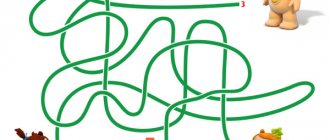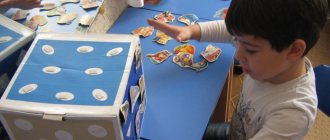Types of classes in preschool educational institutions according to the Federal State Educational Standard
Note-taking methods: how to take notes on history?
The Federal State Educational Standard did not exclude classical lessons, where the teacher presents and explains the material, gives tasks that the children complete, and then sums up the results. But in addition to this type of activity, the program must include innovative activities:
Excursion. Depending on the topic and purpose of the lesson, children are taken to a construction site, library, museum, employment exchange, etc. Collective creative work (CTD). The guys draw or build together and develop a scenario for the event. Labor occupation. Children learn about everyday life in practice: they work in the garden beds and clean the premises. A game. Pupils are invited to play at a store or construction site, or an auction. For example, you can offer this option: whoever talks more about a certain item, advertises it better, is the one who buys it. Individual creativity. Children are encouraged to become craftsmen and inventors. They create crafts and appliqués from available materials. Gatherings. Suitable for studying folklore. Children solve riddles, dance in circles, and sing songs. Fairy tale or theater. The entire lesson is organized as a performance and develops along one storyline. Interview or press conference. One child appears as the main character, the others as journalists. After the interview, the children write down and sketch what interested them. Lesson-help. This is the name for activities aimed at practicing what children are not yet able to do. They are helped by those who have already acquired knowledge or honed a skill. Work is carried out in pairs or groups. Story with discussion. Children are given a task, one person answers, others comment and discuss his actions. Game "Tour Guide". One child talks about something, other children ask him questions. For example, we can talk about a city or animals listed in the Red Book. Research, or problem lesson. The teacher names the problem, and the children look for its solution. For example, you can organize a search for an answer to the question “why study?” Experiment. The student is given some object or substance, he does whatever he wants with it, observes changes and records conclusions
It is important to monitor the safety of children during such lessons. A story based on pictures. The methodology is simple: children or the teacher draw, and then compose a story based on the images. For example, you can make a drawing-essay about visiting kindergarten or about expectations regarding schooling. Competitions and quizzes
You can arrange an activity similar to the game “What? Where? When?" or “Clever or clever.” Or you can divide the children into two teams and discuss some problem from a pros and cons position. Projects. This type creates maximum conditions for creativity and cooperation between the teacher and children, and sometimes parents are also involved. The project can be organized on any topic: economics, ecology, art, mathematics, computer technology. This could be design, modeling or manufacturing.
For example, you can make a drawing-essay about visiting kindergarten or about expectations regarding schooling. Competitions and quizzes. You can arrange an activity similar to the game “What? Where? When?" or “Clever or clever.” Or you can divide the children into two teams and discuss some problem from a pros and cons position. Projects. This type creates maximum conditions for creativity and cooperation between the teacher and children, and sometimes parents are also involved. The project can be organized on any topic: economics, ecology, art, mathematics, computer technology. This could be design, modeling or manufacturing.
In addition, you can organize games like “one day in the life of a fireman” or “firefighter school”. Children imagine themselves in the role of some person and talk about themselves through songs, dances, pantomime, etc.
It is also important to know what an open lesson in kindergarten is. This is a form of reporting, final lesson, to which parents and other teachers are invited. The teacher demonstrates the children’s achievements and his professional successes, the lesson is focused on the present moment in time, the “here and now” principle
An open lesson can also have a different focus: assimilation of knowledge, consolidation of material, combined lesson
The teacher demonstrates the children’s achievements and his professional successes, the lesson is focused on the present moment in time, the “here and now” principle. An open lesson can also have another focus: assimilation of knowledge, consolidation of material, a combined lesson.
Greeting verse for children
Children's poems: to kindergarten | about nature | about vegetables | about fruits | about animals | about school | about the days of the week | about colors
Shape: cool | beautiful | sms | short
So our circle has gathered. A friend gave his hand to a friend. Luda gave her hand to Lesha, and Lesha gave her hand to Vanya..... (about each child in a circle) So our circle gathered. (shake hands together)
2
Hello, golden sun! Hello, blue sky! Hello, free breeze! Hello, little oak tree! We live in the same region - I greet you all! Hello sun! Hello sky! Hello, my whole Earth! We woke up very early and welcome you!
3
Hello right hand - we stretch forward, Hello left hand - we stretch forward, Hello friend - we grab a neighbor with one hand, Hello friend - we grab with the other hand, Hello, hello friendly circle - we shake our hands. We stand hand in hand, together we are a big ribbon, We can be small - we squat, We can be big - we stand up, But no one will be alone
4
Everyone stands in a circle, arms extended forward. I open my palm, the children place their palms on top of my palm, one on top of the other (it turns out to be a “slide” of our palms). Then we lift this “slide” up and all together make a “cracker” on command. I say: “One, two, three” (to these words we raise our hands and stretch up - and we stretch as high as we can reach without separating our hands). "Pop!" At the word “clap,” our common clapper claps to everyone’s joy—the arms quickly spread to the sides like a fountain. If there are few children, then during the circle before the clap we greet each other: “Hello, Tanya (Tanya’s palms rested on our clapper), hello, Sasha, etc.
5
Let's hug you, And let's rise above the ground, Let's unite the warmth of our hearts, And let's become one sun!
6
Hello pens! Clap-clap-clap! Hello legs! Top-top-top! Hello cheeks! Plop-plop-plop! Chubby cheeks? Plop-plop-plop! Hello, little eyes! Blink-blink-blink! Hello sponges! Smack-smack-smack! Hello, teeth! click-click-click! Hello, my nose! Beep-beep-beep! Hello kids! One two Three. Girls and boys, hello!
7
Let's enjoy the sun and the birds, (children raise their hands up) And also enjoy the smiling faces (Smile at each other) And everyone who lives on this planet, (raise their hands) “Good morning!” We will say together (hold hands) “Good morning!” - Mom and Dad “Good morning!” - will stay with us.
8
Let's stand side by side, in a circle, Let's say "Hello!" each other. We are not too lazy to say hello: “Hello!” to everyone! and “Good afternoon!”; If everyone smiles, a good morning will begin. - GOOD MORNING!!!
9
Hello, golden sun! Hello, the sky is blue! Hello, free breeze! Hello, little oak tree! We live in the same region - I greet you all!
10
In the morning we get up with the children in a circle and say: Hello right hand - we stretch forward, Hello left hand - we stretch forward, Hello friend - we grab our neighbor with one hand, Hello friend - we grab it with the other hand, Hello, hello friendly circle - we shake our hands. We stand hand in hand, together we are a big ribbon, We can be small - we squat, We can be big - we stand up, But no one will be alone
11
Hello sun! Hello sky! Hello, my whole Earth! We woke up very early and welcome you!
12
All the children gathered in a circle. I am your friend and you are my friend! Let's hold hands together and smile at each other. We'll hold hands and smile at each other. We'll go in circles. Let's start a round dance. (Walking in a circle) Good morning, eyes! You woke up? Good morning, ears! You woke up? Good morning, hands! You woke up? Good morning, feet! You woke up? The eyes are watching. Ears listen, Hands clap, Feet stomp. Hurray, we're awake!
13
The greeting is accompanied by movements, the children sit on the carpet in a circle: Hello, Heaven! Raise your hands up Hello, Sun! Make a large circle with your hands above your head. Hello, Earth! Smoothly lower your hands onto the carpet Hello, planet Earth! Describe a large circle above your head Hello, our big family! All the guys join hands and raise them up
14
Having run away from the slope, And down the hill - somersault, The Sun rolled along the fence like a bright kolobok. I looked into the fruit garden, stood over the river, and touched a fresh, new leaf with a warm hand. Together with the Sun, Birds, herbs and flowers woke up, They smiled at the Sun together - Smile at him too!
15
Today I will get up early to congratulate everyone around me, because today is Greetings Day! Hello, my dear friend! To everyone I know or not, I will say “Hello”! And I hope that I will hear the same in response!
More poems: <74>
Beginning and ending rituals
The presence of rituals for the beginning and end of a lesson is very important when working with preschoolers in groups. Rituals allow you to better organize children, set them up for work, unite them and create the necessary atmosphere. The organizational moment helps children understand where the lesson begins and where it ends.
The organizational moment helps children understand where the lesson begins and where it ends.
Mathematics classes for preschoolers aged 6-7 years
Examples of rituals for starting and ending classes:
- “Continue the sentence.” The teacher begins the sentence, and the children sitting opposite take turns completing it. For example, the teacher says: “What I like to eat most is... apples” or “My favorite game is... hide and seek.”
- “Pass the signal!” Children sit or stand in a circle and hold hands. The teacher chooses a beginner, and on command he lightly squeezes the hand of the one standing on the left, and the one next. And so on several times until the “signal” transmission speed becomes as fast as possible.
- “Come on, repeat it!” The teacher demonstrates a movement, pose or facial expression, and the kids must repeat it all together.
- “Today I found out...” This ritual is suitable for ending a lesson. Each child begins the construction of his sentence with this phrase and supplements it with what he remembers most from this lesson.
Morning greeting charges you for the whole day
- Physical education session to the same song or melody. A good option would be to start or end the lesson with the selected musical composition. Thanks to this, it will be easy for kids to record the moment of beginning and ending.
- “What am I?” The essence of this ritual is a short story for each little one about himself. Children are given the opportunity to think a little about what they will say, and, starting with the teacher, each child says a few words about himself. There is no point in carrying out this ritual every day, but by periodically returning to it, you can make it clear to children that some qualities and characteristics of a person remain unchanged for a longer time, while others, on the contrary, change every day.
- “The sea is agitated once...” This well-known children's fun is also suitable for the role of a ritual. It is simple, cheerful, but at the same time requires a certain amount of attention from the participants.
There are a great many variations of these rituals, the list is available to everyone. The teacher needs to choose those that are most suitable for his students and the classes he conducts.
Note! It is important to remember that it is better to use different rituals to start and end classes. It is enough to select a few to start with and a few to finish. This will make it easier for children to record these moments.
This will make it easier for children to record these moments.
This will make it easier for children to record these moments.
Organizational aspects in kindergarten classes
Learning to write lesson notes: a guide for parents
The organizational moment in kindergarten before a lesson is the main and first component in the structure of a lesson with children.
Goals of the children's organization
Traditionally, there are several goals for organizing preschool children:
- Attracting the attention of kids.
- The mood for the upcoming activity.
- Creating an atmosphere of unity and cohesion.
- Creating an emotional mood for the lesson.
Organization of children is very important
Attracting children's attention
Org
the moment is needed to attract the attention of children. To do this, you need to loudly and clearly call them to you and, for example, indicate that they need to sit in a semicircle in front of the teacher. Note! In order to motivate the little ones, you can invite them to do this on the count of ten.
This way, kids are more willing to shift their attention away from the activity they were doing.
Note! In order to motivate the little ones, you can invite them to do this on the count of ten. This way, kids are more willing to shift their attention from the activity they were doing. It would also be a good option to recite a counting rhyme or rhyme related to counting at this time.
It would also be a good option to recite a counting rhyme or rhyme related to counting at this time.
Getting ready for upcoming activities
Setting up for the upcoming activity is necessary to improve the children’s concentration. For this purpose, small tasks or an interesting question are best suited to help preschoolers begin directly to the lesson itself. These may be questions asked about past class topics or general topics. It is also useful to ask a short answer question related to the topic of the lesson.
Teachers are responsible for all organizational issues
Create a sense of cohesion and unity
A sense of cohesion and unity is extremely important for a child to feel comfortable in a group. Thanks to them, the preschooler opens up, easily establishes contact with teachers and other children and, accordingly, more easily masters new ones and systematizes the knowledge he already has. You can evoke this feeling using several exercises:
You can evoke this feeling using several exercises:
- “Hug someone else.” The teacher chooses the first starting child, and he hugs the neighbor on the left. The second one also hugs the neighbor on the left. And so on, one by one, until the chain is closed on the beginner.
- "We are together!". The children stand in a circle with the teacher. The teacher invites everyone to hold hands and, raising them up, recite a poem about friendship in chorus.
- Physical education session with the children's song "Smile".
Setting the emotional mood for a lesson in kindergarten
Emotions play a major role in the lives of preschoolers.
Note! If children experience discomfort, they will be emotionally uncomfortable coming to kindergarten, and there is no need to talk about any benefits from the classes. The emotional mood can be perfectly set with the help of music. Moreover, you can select a music playlist based on the topic of the lesson.
Then at the same time you will be able to set the mood and prepare for the upcoming lesson
Moreover, you can select a music playlist based on the topic of the lesson. Then at the same time you will be able to set the mood and prepare for the upcoming lesson
The emotional mood can be perfectly set with the help of music. Moreover, you can select a music playlist based on the topic of the lesson. Then at the same time you will be able to set the mood and prepare for the upcoming lesson.
Reading a poem on the topic with expression will also help achieve this goal. Children should not only go to class, but also to the kindergarten itself with a positive attitude.
Physical education invigorates
Rituals of greeting and farewell
Organization: Kindergarten No. 98
Locality: Kamensk-Uralsky, Sverdlovsk region
I, a new teacher, have been working with young children for two years. As L. S. Vygotsky emphasized, early age is “sensitive in everything.” At an early age, children’s communication with peers begins and develops. Communication with peers enriches the lives of children with new impressions, is a source of bright positive emotions, facilitates the child’s entry into the children’s team, and serves as the basis for the development of new forms of communication between children. The interaction of children with each other differs significantly from the communication of older children and from the communication of a child with an adult. Contacts between young children are built primarily on imitation of each other’s actions, which are accompanied by violent emotional manifestations - screams, squeals, laughter, cheerful grimaces, etc.
The experience of first relationships with peers plays an important role for the further personal and social development of the child, determines the characteristics of the child’s self-awareness, his attitude towards the world and other people.
Considering the importance of the initial stage of children's relationships, in my work I pay special attention to the development of communication and interaction of the child with adults and peers, as well as the familiarization of children with sociocultural norms. Of course, in order for a child to do something, he must first be taught it, only then the child himself will begin to do it, fall in love and improve.
To make it easier for a child to accept “adult rules” and sociocultural norms, in addition to personal example, I use greeting and farewell rituals in my work. Rituals - regularly repeating the same actions
Rituals are especially relevant when working with newly admitted children, because in the process of a child’s adaptation to kindergarten, it is very important to create a psychologically comfortable environment in the group. The greeting ritual allows the child to get ready for the day in kindergarten and performs an important protective function, relieving the child of unnecessary worries and fears.
And the farewell ritual is a summing up of some conclusion, an emotional completion of the process of being in kindergarten. I conduct the farewell ritual on a friendly note, which allows me to gently switch the kids to the meeting of their parents.
I perform the greeting ritual during the morning reception of the children, and the farewell ritual when the children go home. First I establish personal contact with the baby. To do this, I squat down and, looking into the child’s eyes, recite the text of a greeting or farewell poem. I try to choose short poems, with a text that is simple and understandable for young children, and when reciting, I make sure that the tone is friendly and the diction is clear.
The ritual of greeting and farewell in our group is repeated daily. I change the texts of greeting and farewell poems once every two weeks or a month. After all, sometimes more than one day passes before the kids are pleased with the first results: they finish the last words of a rhyme, recite the entire poem, or simply give the warmth of their smile. And sometimes mothers tell how the child repeats the greeting and farewell poem at home, when visiting, that is, he “carries” the experience acquired in kindergarten to the “big world.”
My first experience of using greeting and farewell rituals with young children showed that more and more children are showing interest in greeting and farewell rituals with peers.
I hope that my pedagogical discovery will be interesting for readers, because it does not require material costs, and at the same time, a positive result is obvious, which is manifested in the fact that children have developed basic skills of polite treatment and have developed an experience of friendly relationships, albeit small for now.
Applications:
- file0.docx.. 17.7 KB



